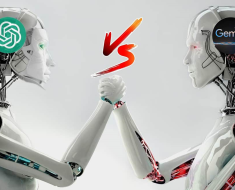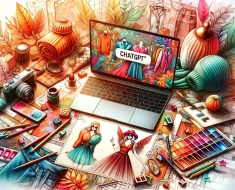Introduction
The ongoing evolution of AI-driven video creation technology continues. Its undeniable impact is reshaping and democratizing the entire video production landscape, representing a significant leap in AI’s role in video creation. But have you ever thought one could create an HD video just by writing a prompt? With the advancements in artificial intelligence, particularly in Natural Language Processing (NLP) and computer vision, creating high-definition videos with a simple prompt has become a reality.
This technology utilizes sophisticated algorithms and deep learning models to interpret and understand the user’s input. By analyzing the prompt, the artificial intelligence system can generate a script, identify relevant visuals, and even mimic human-like storytelling. This process involves understanding the semantics of the prompt and considering elements such as tone, mood, and context.
After the release of text-to-video models such as Gen-2 by Runway, Stable Video Diffusion by Stability AI, Emu by Meta, and the Lumiere by Google. OpenAI, the creator of ChatGPT, announced – Sora, a state-of-the-art text-to-video deep learning model, is designed to create short videos based on text prompts. Although not accessible to the public, the released sample outputs have garnered mixed reactions, with some expressing enthusiasm and others raising concerns, owing to their impressive quality.
Further in this article, we will analyze Sora to understand its working, limitations, and ethical considerations.
Read on!

What is Sora by OpenAI?
OpenAI is continously developing AI to comprehend and replicate the dynamics of the physical world. The aim is to train models that assist individuals in solving real-world interaction problems. Sora is the text-to-video model capable of generating minute-long videos with high visual quality, aligning with user prompts.
Currently, Sora is accessible to red teamers to assess potential harms and risks. Visual artists, designers, and filmmakers can also access access to gather feedback for refining the model for creative professionals. OpenAI is sharing its research progress early to engage with external users and receive feedback, offering a glimpse into upcoming AI capabilities.
For example:
Prompt: A movie trailer featuring the adventures of the 30-year-old spaceman wearing a red wool knitted motorcycle helmet, blue sky, salt desert, cinematic style, shot on 35mm film, vivid colors.
Prompt: The animated scene features a close-up of a short fluffy monster kneeling beside a melting red candle. The art style is 3D and realistic, focusing on lighting and texture. The mood of the painting is one of wonder and curiosity as the monster gazes at the flame with wide eyes and open mouth. Its pose and expression convey a sense of innocence and playfulness as if it is exploring the world around it for the first time. The use of warm colors and dramatic lighting further enhances the cozy atmosphere of the image.
Sora generates intricate scenes with multiple characters, specific motion types, and precise subject and background details. The model comprehends the user’s prompt and how those elements exist in the physical world. With a profound understanding of language, Sora accurately interprets prompts and creates captivating characters expressing vivid emotions. It can produce multiple shots in a single video, maintaining consistency in characters and visual style.
Sora’s use cases extend beyond text-to-video, including animating still images, continuing videos, and video editing. Despite its remarkable capabilities, OpenAI acknowledges potential risks and ethical concerns, emphasizing the need for external input and feedback. You can comprehend the criticality and importance of this model in our daily life. For instance, a graphic designer can use it for image animation, video continuation, editing, and more. An instructor in the education sector can create animated images for their students. It will also be useful for architecture and biology students.
Link to the Website: Sora by OpenAI
Use Cases of Sora by OpenAI
Applications of Sora by OpenAI:
- Text-to-Video:
- Sora excels in converting textual instructions into visually engaging videos, allowing users to translate ideas into dynamic visual content seamlessly.
- Image Animation:
- The model can bring still images to life by animating them, introducing movement and vitality to static visuals.
- Video Continuation:
- Sora can extend existing videos, providing a seamless continuation of scenes and narratives and enhancing storytelling possibilities.
- Video Editing:
- Users can leverage Sora for video editing tasks, such as altering backgrounds or settings within a video, showcasing its versatility in enhancing and modifying visual content.
How Does Sora by OpenAI Work?
The model’s architecture comprises a visual encoder, diffusion Transformer, and visual decoder.
- The visual encoder compresses videos into a latent space, representing reduced dimensionality.
- The diffusion Transformer generates sequences of visual patches based on user prompts, and the visual decoder reverses the encoding, producing the final video.
Sora showcases emerging properties, demonstrating a level of understanding in 3D consistency, long-range coherence, object permanence, interaction, and simulating entire digital worlds. However, it exhibits limitations, such as physics and biology missteps, broken causality, and a lack of detailed control for creatives.
OpenAI anticipates Sora’s significant impact on creativity but acknowledges the need to address safety threats, collaborate with experts, implement filters, and add AI-generated metadata to flag videos. Ethical concerns include transparency about the model’s training data, copyright issues, and power concentration, as OpenAI substantially influences AI innovation.
While Sora’s potential is vast, OpenAI’s monopoly on powerful AI models raises concerns about transparency, accountability, and ethical considerations in the broader AI landscape.
Limitations of Sora Model
The existing Sora model exhibits certain limitations. It faces challenges in faithfully simulating the intricate physics of a complex scene, often leading to inaccuracies in depicting specific cause-and-effect instances. As an illustration, it may falter in representing a person taking a bite out of a cookie, resulting in a discrepancy where the cookie lacks the expected bite mark.
Additionally, the model can encounter difficulties in maintaining spatial accuracy within a given prompt, occasionally confusing left and right orientations. Furthermore, it may grapple with providing precise descriptions of events unfolding over time, such as accurately tracking a specific camera trajectory.
Prompt: Step-printing scene of a person running, the cinematic film shot in 35mm.
Weakness: Sora sometimes creates physically implausible motion.
Prompt: Basketball through hoop then explodes.
Weakness: An example of inaccurate physical modeling and unnatural object “morphing.”
Despite these drawbacks, ongoing research and development efforts aim to enhance the model’s capabilities, addressing these issues and advancing its proficiency in delivering more accurate and detailed simulations of various scenarios.
The Comparison of Text-to-Video Tool: Lumiere Vs Sora

- Video Quality:
- Lumiere was recently released, boasting superior video quality compared to its predecessors.
- On the other hand, Sora demonstrates greater power than Lumiere, capable of generating videos up to 1920 × 1080 pixels with versatile aspect ratios, while Lumiere is confined to 512 × 512 pixels.
- Video Duration:
- Lumiere’s videos are limited to around 5 seconds, whereas Sora can create videos with a significantly extended duration, up to 60 seconds.
- Multi-shot Composition:
- Lumiere lacks the capability to create videos composed of multiple shots, while Sora excels in this aspect.
- Video Editing Abilities:
- Sora, akin to other models, exhibits advanced video-editing capabilities, including tasks such as creating videos from images or existing videos, combining elements from different sources, and extending video duration.
- Realism and Recognition:
- Both models produce videos with a broadly realistic appearance, but Lumiere’s AI-generated videos may be more easily recognized.
- Sora’s videos, however, display a dynamic quality with increased interactions between elements.
The decision between Lumiere and Sora hinges on individual preferences and requirements, encompassing aspects like video resolution, duration, and editing capabilities. Both Lumiere and Sora exhibit inconsistencies and reports of hallucinations in their output; ongoing advancements in these models may address current limitations, fostering continual improvements in AI-generated video production. Moreover, Sora from OpenAI features enhanced framing and compositions, enabling you to generate content tailored to various devices while adhering to their native aspect ratios.
Also read: 11 AI Video Generators to Use in 2024: Transforming Text to Video
Ethical Constraints in the Current Sora Model
The introduction of the Sora model by OpenAI raises serious concerns about its potential misuse in generating harmful content, including but not limited to:
- Creation of Pornographic Content:
- Sora’s ability to generate realistic and high-quality videos based on textual prompts may pose a risk in the creation of explicit or pornographic material. Malicious users could leverage the model to produce inappropriate, exploitative, and harmful content.
- Propagation of Fake News and Disinformation:
- Sora’s text-to-video capabilities can be misused to create convincing fake news or misinformation. For example, the model could generate realistic-looking videos of political leaders making false statements, spreading misinformation, and potentially harming public perception and trust.
- Creation of Content Endangering Public Health Measures:
- Sora’s ability to generate videos based on prompts raises concerns about creating misleading content related to public health measures. Malicious actors could use the model to create videos discouraging vaccination, promoting false cures, or undermining public health guidelines, jeopardizing public safety.
- Potential for Disharmony and Social Unrest:
- The realistic nature of videos generated by Sora may be exploited to create content that stirs disharmony and social unrest. For instance, the model could generate videos depicting false violence, discrimination, or unrest incidents, leading to tensions and potential real-world consequences.
OpenAI recognizes the potential for misuse and is taking steps to address safety concerns. We will discuss this in the section below.
OpenAI’s Safety Measure for Sora Model
OpenAI is implementing several crucial safety measures prior to the release of the Sora model in their products. Key points include:
- Red Teaming Collaboration
- OpenAI is collaborating with red teamers, experts in domains such as misinformation, hateful content, and bias.
- These experts will conduct adversarial testing to evaluate the model’s robustness and identify potential risks.
- Misleading Content Detection Tools
- OpenAI is developing tools, including a detection classifier, to identify misleading content generated by Sora.
- The goal is to enhance content scrutiny and maintain transparency in distinguishing between AI-generated and authentic content.
- C2PA Metadata Integration
- OpenAI plans to include C2PA metadata in the future deployment of the model within their products.
- This metadata will serve as an additional layer of information to indicate whether a video was generated by the Sora model.
- Utilizing Existing Safety Methods
- OpenAI is leveraging safety methods already established for products using DALL·E 3, which are relevant to Sora.
- Techniques include a text classifier to reject prompts violating usage policies and image classifiers to review generated video frames for policy adherence.
- Engagement with Stakeholders
- OpenAI will engage with policymakers, educators, and artists globally to understand concerns and identify positive use cases.
- The aim is to gather diverse perspectives and feedback to inform responsible deployment and usage of the technology.
- Real-world Learning Approach
- Despite extensive research and testing, OpenAI acknowledges the unpredictability of technology use.
- Learning from real-world use is deemed essential for continually enhancing the safety of AI systems over time.
Moreover, the collaboration with external experts, implementing filters, and adding AI-generated metadata to flagged videos. However, the risk remains that Sora could contribute to the proliferation of harmful content, emphasizing the need for responsible use and ongoing monitoring of its deployment in various contexts.
Conclusion
In a nutshell, Sora, a diffusion model generates videos by transforming static noise gradually. It can generate entire videos at once, extend existing videos, and maintains subject continuity even during temporary out-of-view instances. Similar to GPT models, Sora employs a transformer architecture for superior scaling performance. Videos and images are represented as patches, allowing diffusion transformers to be trained on a wider range of visual data, including varying durations, resolutions, and aspect ratios. Building on DALL·E and GPT research, Sora incorporates the recaptioning technique from DALL·E 3, enhancing fidelity to user text instructions in generated videos. The model can create videos from text instructions, animate still images accurately, and extend existing videos by filling in missing frames. Sora is seen as a foundational step towards achieving Artificial General Intelligence (AGI) by understanding and simulating the real world.
If you find this article on the latest model – Sora by OpenAI, then comment of the section given below. I will appreciate your opinion.
Podcast: Play in new window | Download





